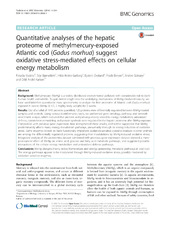Quantitative analyses of the hepatic proteome of methylmercury-exposed Atlantic cod (Gadus morhua) suggest oxidative stress-mediated effects on cellular energy metabolism
| dc.contributor.author | Yadetie, Fekadu | en_US |
| dc.contributor.author | Bjørneklett, Silje | en_US |
| dc.contributor.author | Garberg, Hilde K | en_US |
| dc.contributor.author | Oveland, Eystein | en_US |
| dc.contributor.author | Berven, Frode | en_US |
| dc.contributor.author | Goksøyr, Anders | en_US |
| dc.contributor.author | Karlsen, Odd André | en_US |
| dc.date.accessioned | 2016-08-09T09:58:48Z | |
| dc.date.available | 2016-08-09T09:58:48Z | |
| dc.date.issued | 2016-08-05 | |
| dc.identifier.uri | https://hdl.handle.net/1956/12520 | |
| dc.description.abstract | Background: Methylmecury (MeHg) is a widely distributed environmental pollutant with considerable risk to both human health and wildlife. To gain better insight into the underlying mechanisms of MeHg-mediated toxicity, we have used label-free quantitative mass spectrometry to analyze the liver proteome of Atlantic cod (Gadus morhua) exposed in vivo to MeHg (0, 0.5, 2 mg/kg body weight) for 2 weeks. Results: Out of a toltal of 1143 proteins quantified, 125 proteins were differentially regulated between MeHg-treated samples and controls. Using various bioinformatics tools, we performed gene ontology, pathway and network enrichment analysis, which indicated that proteins and pathways mainly related to energy metabolism, antioxidant defense, cytoskeleton remodeling, and protein synthesis were regulated in the hepatic proteome after MeHg exposure. Comparison with previous gene expression data strengthened these results, and further supported that MeHg predominantly affects many energy metabolism pathways, presumably through its strong induction of oxidative stress. Some enzymes known to have functionally important oxidation-sensitive cysteine residues in other animals are among the differentially regulated proteins, suggesting their modulations by MeHg-induced oxidative stress. Integrated analysis of the proteomics dataset combined with previous gene expression dataset showed a more pronounced effect of MeHg on amino acid, glucose and fatty acid metabolic pathways, and suggested possible interactions of the cellular energy metabolism and antioxidant defense pathways. Conclusions: MeHg disrupts mainly redox homeostasis and energy generating metabolic pathways in cod liver. The energy pathways appear to be modulated through MeHg-induced oxidative stress, possibly mediated by oxidation sensitive enzymes. | en_US |
| dc.language.iso | eng | eng |
| dc.publisher | BioMed Central Ltd. | eng |
| dc.rights | This article is distributed under the terms of the Creative Commons Attribution 4.0 International License (http://creativecommons.org/licenses/by/4.0/), which permits unrestricted use, distribution, and reproduction in any medium, provided you give appropriate credit to the original author(s) and the source, provide a link to the Creative Commons license, and indicate if changes were made. The Creative Commons Public Domain Dedication waiver (http://creativecommons.org/publicdomain/zero/1.0/) applies to the data made available in this article, unless otherwise stated. | eng |
| dc.rights.uri | http://creativecommons.org/licenses/by/4.0/ | eng |
| dc.title | Quantitative analyses of the hepatic proteome of methylmercury-exposed Atlantic cod (Gadus morhua) suggest oxidative stress-mediated effects on cellular energy metabolism | en_US |
| dc.type | Peer reviewed | |
| dc.type | Journal article | |
| dc.date.updated | 2016-08-05T16:03:09Z | |
| dc.description.version | publishedVersion | en_US |
| dc.rights.holder | The Author(s). | |
| dc.identifier.doi | https://doi.org/10.1186/s12864-016-2864-2 | |
| dc.identifier.cristin | 1386907 | |
| dc.source.journal | BMC Genomics | |
| dc.subject.nsi | VDP::Matematikk og Naturvitenskap: 400::Basale biofag: 470 | en_US |
Tilhørende fil(er)
Denne innførselen finnes i følgende samling(er)
Med mindre annet er angitt, så er denne innførselen lisensiert som This article is distributed under the terms of the Creative Commons Attribution 4.0 International License (http://creativecommons.org/licenses/by/4.0/), which permits unrestricted use, distribution, and reproduction in any medium, provided you give appropriate credit to the original author(s) and the source, provide a link to the Creative Commons license, and indicate if changes were made. The Creative Commons Public Domain Dedication waiver (http://creativecommons.org/publicdomain/zero/1.0/) applies to the data made available in this article, unless otherwise stated.

